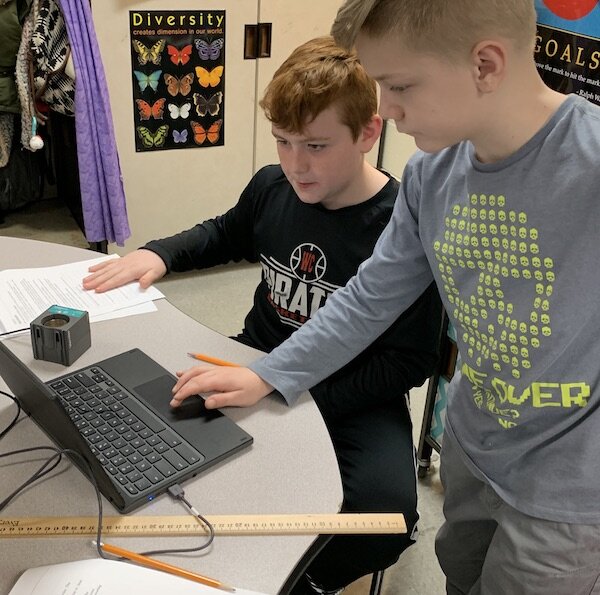Developing an Engineering Mindset
“It’s important for students to understand, at any early age, that engineering is something everyone can do.”
-Laura Drager
Laura Drager, a fifth grade teacher at Harold Schnell Elementary School in West Carrollton, was inspired by the “Light, Color, Race” unit published on the Dayton Regional STEM Center’s website to challenge her students to build a solar car and measure and change its speed using their knowledge of the properties of light.
Ms. Drager received a STEM Aspire Microgrant through the STEM Center, where she has participated as a STEM Fellow and Team Lead as part of its professional development program for teachers, to purchase solar car kits and motion sensors for her students. The microgrant, which is funded by the Martha Holden Jennings Foundation, allows them access to technology when working with the engineering design process.
“This is important to help students develop an engineering mindset,” Ms. Drager says, explaining that she has assigned a project similar to this one to her students in the past but set out to enhance their work this year by incorporating the new motion sensors into the exercise. “Experience working with technology and the engineering design process helps them feel comfortable using it going forward in life.”
The project begins with students experimenting with the properties of light. They explore the visible light spectrum by using light diffraction grating glasses and prisms. They investigate reflection, refraction, and absorption of light using flashlights and various materials such as foil, mirrors, construction paper, tape, and color filters. (These items are used later when changing the speed of their cars by adding the materials to the vehicle’s solar panels.)
After learning about the properties of light, students work in teams to build a gear-driven solar car. Having students build their vehicles, Ms. Drager says, is a great hands-on activity to practice engineering in teams. Once completed, the students race their cars outside and learn to calculate the distance the car travels in meters by the seconds it takes to travel. Before receiving the motion sensors, students made their calculations using a stopwatch. This year the plan was for teams to connect the motion sensors to Chromebooks to measure their car’s speed. The data would then be transferred to an application, Vernier Graphical Analysis, that instantaneously graphs the results.
Approximately 100 students used the motion sensors before school closed due to COVID19. (Since the materials are reusable, approximately 100 fifth grade students will have the opportunity to use the solar cars and motion sensors every year for the foreseeable future.)
“I want students to believe that STEM is not intimidating, but rather the way the world works.”
-Laura Drager
“Students always love trying something new and different in school.” Ms. Drager remarks. “I’ve never met a student who had already built and tested the speed of a solar car with a motion sensor before, so the fact that they are having a new experience in the classroom is very engaging. They naturally have a sense of competition, as well, and they love racing their solar cars to see which goes the fastest (even if that’s not the goal of the project)! Ultimately, kids love movement and working with their hands; this project involves a lot of both of those.”
After learning about the properties of light and measuring speed, the final task is for teams to engineer a way to control the speed of their solar cars. For example, if the original speed is 10 meters per second, they may be tasked to engineer a car that can travel 5 meters per second. The materials used in the beginning of the project can now be used to alter the solar panel affixed to the car, thereby changing its speed. While students are testing their designs, the motion sensors provide instant feedback about how their designs affect the car’s speed. Real-time graphs allow students to analyze motion in a meaningful way, Ms. Drager remarks.
Unfortunately, Ms. Drager was not able to complete the project with students this spring due to COVID19. Because students share materials, they were also unable to finish their assignment through distance learning. Ms. Drager is hopeful she will get the opportunity to complete the project in its entirety next spring.
“I want students to believe that STEM is not intimidating, but rather the way the world works,” Ms. Drager says, commenting on what she hopes students learn from this assignment. “I want them to feel a sense of accomplishment when using the engineering design process and technology devices so that they are more likely to use them in future. My hopes are that they fall in love with STEM and are encouraged to go into a STEM field in the future, when they might not have chosen that career path otherwise.
“Students naturally have a sense of competition,” says Laura Drager, “and they enjoy racing their solar cars to see which are fastest.”
“Using technology with students can be intimidating and overwhelming,” she adds, “but the payoff is worth it!”
The Dayton Regional STEM Center Fellowship program is an excellent professional development program that encourages teachers to use high quality STEM education in their classrooms. Their website (http://daytonregionalstemcenter.org/stem-curriculum/) offers free curriculum to teachers of grades K-12. It’s an excellent resource for teachers!





